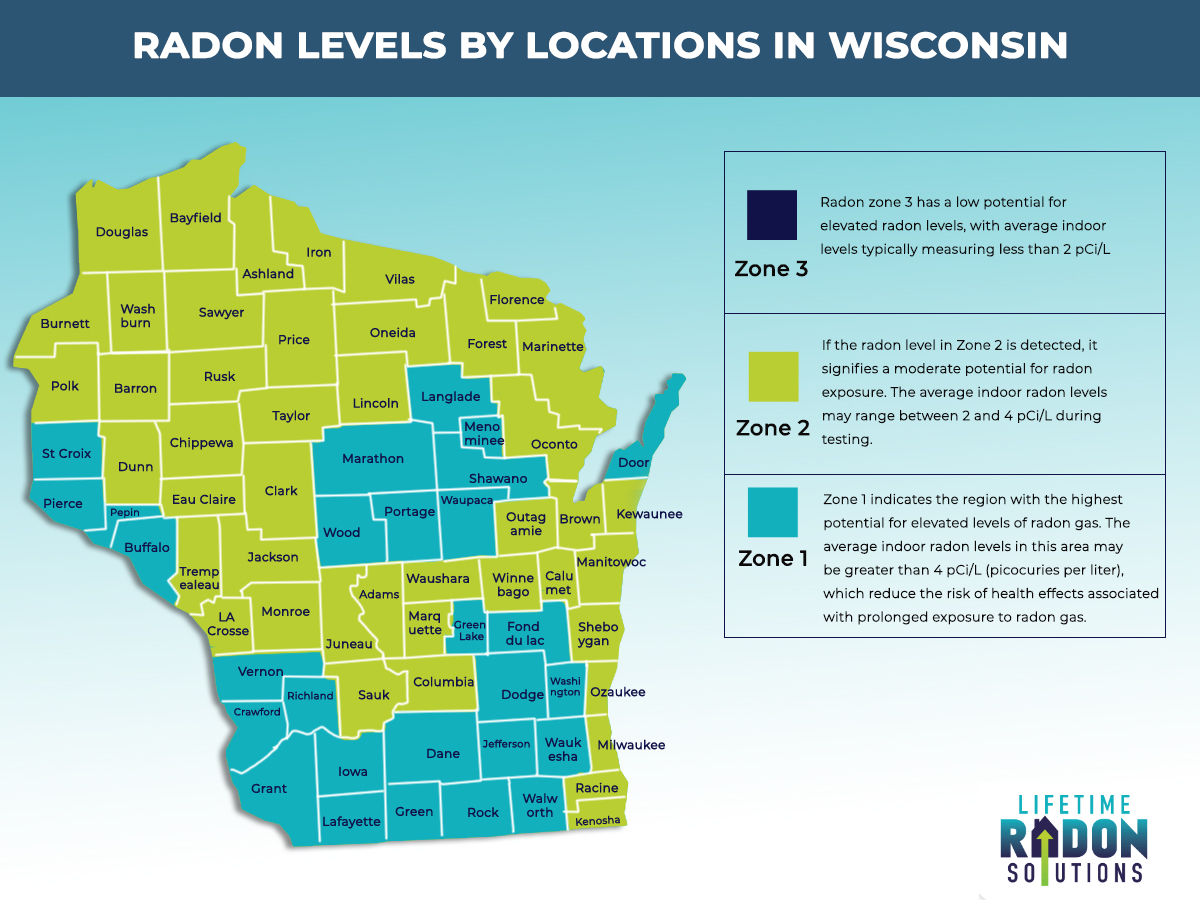Radon Levels by Locations in Wisconsin

You may be living in Wisconsin or thinking about moving there. Wisconsin's indoor environment, be it residential, educational, or occupational, typically contains high levels of Rn. Thus, protecting yourself and your loved ones from radon exposure is crucial to avoid serious problems like lung cancer or respiratory issues.
You may be apprehensive about radon exposure, naturally. Radon is a deadly radioactive gas, but with proper help, you can keep yourself and your dear ones safe from it. Lifetime Radon is a reliable radon testing and mitigation service provider in Wisconsin, offering cost-effective and secure solutions to reduce the risk of radon exposure. So if you want to know more about radon levels in Wisconsin and what you can do about them, keep reading!
Overview of Radon and its Health Implications
Radon is a radioactive gas occurring naturally in the ground beneath us and can enter indoor spaces. It is a silent killer since it has no odor and can be dangerous. It is necessary to take measures to prevent radon exposure to ensure the safety of ourselves and our loved ones.
The Wisconsin Department of Health Services estimates in some areas of Waukesha County, Washington County, and Dodge County, the number of homes with radon levels above EPA guidelines on the main floor could be as high as 60%!
Radon is a harmful gas that can take years to manifest its effects, but once it does, it can lead to serious health problems. Prioritizing testing in residential and commercial spaces is crucial to detect high radon levels. Ensuring the safety of individuals in these spaces should be a top concern.
Average Radon Levels in Wisconsin
Did you know Wisconsin has an estimated mean radon level of 5.7 pCi/L, slightly higher than the national average of 1.3 pCi/L? That's right, almost 1 out of every 9 homes in Wisconsin may have higher radon levels than the Environmental Protection Agency's recommended level!
And get this - nearly two-thirds of the state's counties fall under zone 1, which means there's a more significant potential for elevated indoor radon levels.
The radon zone map was created in 1993 to provide information on the potential level of radon gas in a given area. It's important to understand that the level of exposure and risk to your health may vary depending on your zone. Unfortunately, there is no way to determine the radon level in your indoor space without testing, so it's wise to consider professional testing to minimize potential risks.
Zone 3
Radon zone 3 has a low potential for elevated radon levels, with average indoor levels typically measuring less than 2 pCi/L. However, it's important to note that Wisconsin has higher radon levels and therefore does not have a zone 3 designation. This means that residents of Wisconsin should take extra precautions to test their homes for radon and implement mitigation strategies if necessary.
Zone 2
If the radon level in Zone 2 is detected, it signifies a moderate potential for radon exposure. The average indoor radon levels may range between 2 and 4 pCi/L during testing. It is crucial to take necessary precautions and measures to reduce radon levels to ensure a safe indoor environment.
Here are the areas in Wisconsin that come under Zone 2-
| Douglas | Bayfield | Ashland | Iron | Vilas |
| Forest | Florence | Marinette | Oconto | Lincoln |
| Eau Claire | Chippewa | Clark | Jackson | Trempealeau |
| Marquette | Manitowoc | Sawyer | Polk | Burnett |
| Sauk | Sheboygan | Barron | Adams | Taylor |
| Columbia | Ozaukee | Juneau | Monroe | Price |
| Winnebago | Milwaukee | Oneida | Rusk | Outagamie |
| Calumet | Racine | Dunn | Washburn | Kewaunee |
| Brown | Kenosha | Waushara | LA Crosse |
Zone 1
Regarding radon levels in indoor spaces, Zone 1 indicates the region with the highest potential for elevated levels of radon gas. It means that the average indoor radon levels in this area may be greater than 4 pCi/L (picocuries per liter), which is a level that requires action to be taken to reduce the risk of health effects associated with prolonged exposure to radon gas.
Here are the Areas in Wisconsin that Come Under Zone 1
| St Croix | Pierce | Pepin |
| Richland | Waukesha | Buffalo |
| Grant | Dodge | Vernon |
| Iowa | Washington | Crawford |
| Lafayette | Fond du lac | Langlade |
| Green | Green Lake | Menominee |
| Dane | Waupaca | Shawano |
| Rock | Wood | Door |
| Walworth | Portage | |
| Jefferson | Marathon |
Know Your Radon Levels!
It is important to note that radon levels can fluctuate depending on the season. To ensure your safety, you should compare your test results to determine any necessary actions you should take. As you may be aware, exposure to radon gas can be hazardous to your health. We are committed to helping you navigate this process and providing guidance every step of the way.
Contact us!
If you are concerned about the radon levels in your home, worry no more because we're here to help!
Our team of experts provides various services, including property inspections, radon water testing, home warranties, and more. We understand that your family's health is a top priority, so we're dedicated to ensuring your home is safe from radon threats.
By working with us, you'll have peace of mind knowing that your radon levels are under control. Learn more about our services here, and feel free to contact us today.
 262-955-5701
262-955-5701




